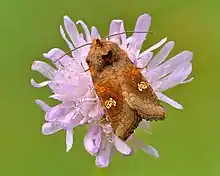Amphipoea oculea
Amphipoea oculea, the ear moth, is a moth of the family Noctuidae. It was first described by Carl Linnaeus in 1761 and it is found in most of the Palearctic realm. It is one of four species that are difficult to tell apart, requiring the examination of the genitalia. The larvae feed in the stems and roots of low plants and grasses.

| Amphipoea oculea | |
|---|---|
 | |
| Scientific classification | |
| Domain: | Eukaryota |
| Kingdom: | Animalia |
| Phylum: | Arthropoda |
| Class: | Insecta |
| Order: | Lepidoptera |
| Superfamily: | Noctuoidea |
| Family: | Noctuidae |
| Genus: | Amphipoea |
| Species: | A. oculea |
| Binomial name | |
| Amphipoea oculea (Linnaeus, 1761) | |
| Synonyms[1] | |
|
List
| |
Description
The wingspan is 29–34 mm. Forewing pale or dark ferruginous brown; the veins brown; inner and outer lines double, brown, wide apart; the inner curved outwards between, and toothed inwards on, the veins; the outer with the inner arm thin, lunulate-dentate, the outer thick, continuous and parallel; a thick dark median shade running between the stigmata; submarginal line indistinct, waved, angled on vein 7, above which it is preceded by a dark costal patch; orbicular stigma rounded, orange, with a brown ring; reniform white, with the veins across it brown and containing on the discocellular a brown-outlined lunule, of which the centre is yellowish; the colour with brown outline; hindwing fuscous grey, paler towards base; the fringe rufous tinged.[2]
Adults are found from June to September depending on the location. There is one generation per year. At night the moths come to light and to flowers, honeydew and sugar. During the day it feeds at the flowers of thistles and ragwort.[3][4]
.JPG.webp)

The larvae feed, from April to June, on the stems and roots of various grasses and low plants, including butterbur (Petasites hybridus) and tufted hair-grass (Deschampsia cespitosa); preferring damp habitats.[3][5]
Similar species
Requiring genitalic examination to separate. See Townsend et al.[6]
- Crinan ear (Amphipoea crinanensis)
- large ear (Amphipoea lucens)
- saltern ear (Amphipoea fucosa)
Taxonomy
Carl Linnaeus, when describing the moth, placed it in the genus Phalaena, from a specimen found in Sweden. Phalaena is now an obsolete genus which was used by Linnaeus to house most of the moths. The moth is now placed in the genus Amphipoea which was raised by the Swedish anatomist Gustaf Johan Billberg in 1820. Amphipoea refers to Amphi – round and poa – grass; i.e. the habitat. The specific name, oculea, means eyed, from the reniform stigma, which British entomologists referred to as an 'ear'.[7]
References
- "Amphipoea oculea (Linnaeus, 1761)". Fauna Europaea. Retrieved 17 August 2023.
- Seitz, A. Ed., 1914 Die Großschmetterlinge der Erde, Verlag Alfred Kernen, Stuttgart Band 3: Abt. 1, Die Großschmetterlinge des palaearktischen Faunengebietes, Die palaearktischen eulenartigen Nachtfalter, 1914
- Kimber, Ian. "Ear Moth Amphipoea oculea (Linnaeus, 1761)". UKmoths. Retrieved 17 August 2023.
- Goater, Barry (1983). Heath, John; Emmet, A Maitland (eds.). Amphipyrinae. In The Moths and Butterflies of Great Britain and Ireland. Volume 10. Colchester: Harley Books. pp. 238–40. ISBN 0-946589-01-1.
- Robinson, Gaden S.; Ackery, Phillip R.; Kitching, Ian J.; Beccaloni, George W.; Hernández, Luis M. "Search the database - introduction and help". HOSTS - A Database of the World's Lepidopteran Hostplants. Natural History Museum, London.
- Martin C. Townsend, Jon Clifton and Brian Goodey (2010). British and Irish Moths: An Illustrated Guide to Selected Difficult Species. (covering the use of genitalia characters and other features) Butterfly Conservation.
- Emmet, A Maitland (1991). The Scientific Names of the British Lepidoptera. Their History and Meaning. Colchester: Harley Books. p. 213 & 216. ISBN 0 946589 28 3.
External links
- Savela, Markku. "Amphipoea oculea (Linnaeus, 1761)". Lepidoptera and Some Other Life Forms. Retrieved June 28, 2019. Taxonomy
- Lepidoptera of Belgium Archived 2017-04-06 at the Wayback Machine
- De Vlinderstichting (in Dutch)
- Lepiforum e.V. Includes photo of genitalia